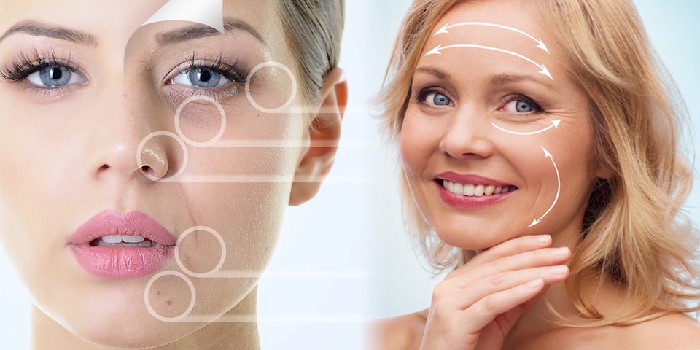Getting old and wrinkles may go hand in hand, but they no longer need to. What exactly changes inside your skin over the years, allowing those pesky lines to appear? According to board certified plastic surgeon Dr. Tracy Pfeifer, the root of all wrinkles is collagen loss.
When you have a loss of collagen in a particular spot, you get a line. A line, literally, is a loss of collagen. – Dr. Pfeifer
What is Collagen?
For starters, it is the most abundant protein present inside the body. It keeps your joints working, strengthens the muscles and bones, and it is the reason your skin was firm and smooth in your youth. Your body is always making collagen and your body is always breaking collagen down.
“When you were twelve years old, you were frowning and smiling and doing all these things, but you didn’t have crows’ feet, and you didn’t have the eleven lines,” points out Dr. Pfeifer. “That is because your collagen production was super high when you were twelve. So even though when you were twelve, every time you frowned, you were breaking down the collagen, your body would instantly replace it with new collagen.”
Over time, however, especially as we enter into our thirties and beyond, the body’s production of collagen begins to slow down. The same breakdown of collagen is occurring that took place in youth, but the replacement of collagen is much less. As a result, wrinkles begin to show.
Since everything about fine lines relates to collagen, the best way to fight back is to focus on collagen. There are methods available to slow collagen loss, replace lost collagen and boost collagen production. “You should attack it in a multi-modality way,” emphasizes Pfeifer. “You shouldn’t just do one thing, you should do a combination of things to get the best results.”
A Multi-Modality Approach to Combat Fine Lines
- Slow Collagen Loss
- Replace Lost Collagen
- Boost Collagen Production
BOTOX
One method Dr. Pfeifer uses to slow down the loss of collagen in the skin is Botox or Dysport injections. When facial muscles are active and strong, their movement causes the skin to fold and crease. Every time you use those muscles to squint, frown or make an expression, the skin above the muscle moves. Anytime the skin creases, collagen within the skin is broken down. By relaxing strong facial muscles with Botox or Dysport, creasing of skin is diminished and as a result collagen loss is slowed down.

FILLERS
Depending on how much collagen has been lost before Botox treatment begins, some residual lines may still be visible. In those cases, facial fillers can be used to replace the lost collagen and plump out the crease, erasing the visible wrinkle.

If you want long-lasting results from facial fillers, you need to make sure the area has been treated with Botox first. “You don’t want to just jump to putting filler in if the area still has a lot of movement and the area hasn’t been treated with Botox,” cautions Dr. Pfeifer. “The muscle movement and the repetitive creasing of the skin is going to break down the Juvederm, or whatever product you’re using, very quickly. So, you need to do both. You need to do Botox or Dysport first, and then, if you have a residual line, you can put a little filler in.”
SKINCARE
Many skincare products boast labels claiming to boost collagen and firm your skin, but not all of those products deliver on their promise. Dr. Pfeifer recommends looking for skincare products containing one of these three active ingredients: Retin-A, retinol or peptides. Retin-A is the strongest of the three, requiring a prescription. Retinol and peptides can be found in many over-the-counter products.

“Retin-A stimulates the cells to literally make more collagen,” explains Pfeifer. “Everybody should be on a Retin-A or a retinol-type product. Peptides also work to increase the collagen level in the skin.”
Boost collagen production in the skin with skincare products containing:
- Retin-A
- Other retinols
- Peptides
CHEMICAL PEELS or LASER TREATMENTS
Your skin responds to damage by creating additional collagen in order to heal itself. For example, any cut of the skin is healed by a scar formed out of collagen. Lasers and chemical peels are a method of delivering controlled damage to the skin in order to produce a collagen healing response.
“You’re basically damaging the skin,” explains Pfeifer. “As it repairs itself, it is creating collagen. When you’re healing from a chemical peel or a laser treatment, the collagen levels are building up, and as a result it smoothes out the creases in the skin.”















Facebook
Twitter
Instagram
YouTube
RSS